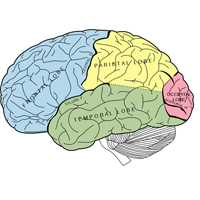Why Is Color?
This seems like a strange question. However it is so important that it is actually the name of this website whyiscolor.org. More typically people ask (and answer) the question, "What is color?" That is simply to answer; color is a human perception! "Why is color?" is far more difficult to answer and that is the way we have come to prefer to ask the question in our laboratory (the Munsell Color Science Laboratory). In answering why, one can ponder the reasons we have the perception of color as well as how those perceptions are produced. The image above and its explanation describe how color perceptions are produced and they go a long way toward explaining why. After all, the "what" is a big part of the "why". For example, we could just say that we have color perceptions because our eyes have three cone photoreceptor types that respond to stimuli produced by the interactions of light sources and materials to produce neural signals that our brain can interpret as color.
Looking deeper into the "why" part of the question leads us somewhat out of the domains of the objective sciences of physics, chemistry, anatomy, physiology, psychology and the mathematical language used in all of them. We quickly end up in a more philosophical place. However we don't need to fixate solely on the philosophy. Perhaps the simple answer that color perception makes the world a more beautiful place for us (most of the time) is enough to satisfy the philosophical question. We can then fall back on some biological science to examine the question of why humans evolved to have color perceptions, or even more specifically why they are trichromatic.
The most widely accepted theories on the evolution of color vision are that it serves human survival in three ways. These are to help identify healthy (and willing) mates, to identify healthful and ripe food, and to warn us of potential dangers. Other creatures have evolved, and survive very well, with very different types of visual systems. Some have more than three receptor types (e.g., some birds, fish, insects, and famously the mantis shrimp). Others survive quite well with dichromatic color vision (e.g., most mammals). So the answer is not the same for all species and that only makes sense. All species don't have wings, or gills, or stingers, or fangs either. Another important aspect of our color vision system is how well it matches our environment. For example our eyes respond to the wavelengths of energy most prevalent in our main light source, the sun. And statistical analyses have shown that three types of cone photoreceptors are adequate to describe the variability in the spectra of natural objects (having four wouldn't really help us, but three is significantly more helpful than two).
Why is color, indeed?
![]()
Explore the NEXT TOPIC at this level.
There are no more levels to explore! Congratulations for reaching the top. If you are interested in more, these discussions of SEEING fall under the scientific discipline of visual EXPERIMENTAL PSYCHOLOGY.
Ever wonder ... What is color?
Updated: Apr. 20, 2011

